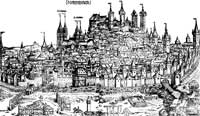Albrecht Dürer's Nuremberg
Albrecht Dürer the artist, and his personality, can be better understood if we have a look at his birthplace, and the influence the teaching spirit of the century had both on the daily life and on the minds of the artists.

Hartmann Schedel - View of the City of Nuremberg, 1493
Bayerische Staatsbibliothek, Munich
Nuremberg had a special position in Germany. It was a free imperial town, and enjoyed a great number of privileges, which favored the development of commerce, and the formation of a successful, wealthy middle class. As the Medici in Florence, powerful merchants ascended to the highest political status, and encouraged the development of arts, one of them being the humanist Willibald Pirkheimer, a good friend of Dürer.
The environment was humanistic par excellence. The craftsmen of Nuremberg did not simply produced woodcarvings or statues, they perfected their work, and they really had an artistic mind, the works transmitting their thoughts to the viewer.
The town spirit promoted not only the arts, but also physics and science. The first paper-mill in Germany was established here. The printing press set up by Anton Koberger was the second after Gutenberg’s one in Mainz. Thus, the town was able to produce its own paper and print its own books. In the beginning, mainly Bibles, Psalters, and prayer books were printed, but as the number of writers increased, chronicles, histories, scientific treatises or satires made their way to the press.
Nuremberg was the city of scientists like the astronomer Regiomontanus, and Martin Behaim, the cosmographer who designed the first terrestrial globe. Now the scientific knowledge could be made publicly available, and Regiomontanus alone had twenty one works printed
People with money were proud to promote the artists and scientists. Bernard Walther assisted Regiomontanus in constructing the first observatory in Europe, and performing regular astronomical research.
In the same note of creativity, a man of the town, Peter Hele, invented the watch. Clock-makers were among the most distinguished citizens, and Hans Bullman was the first to set up a true astronomical clock. Organ makers were renowned in all Germany, as were the glass painters.
Still, it appears that the goldsmith trade was the most important. Many master goldsmiths were working in Nuremberg, and their elegant creations, real works of art, were held in high esteem all over Europe.
No wonder that Albrecht Dürer’s father came here to try his luck as a goldsmith.
And Nuremberg was not promoting only the practical spirit. Beauty was promoted side by side with the utility, and, in the same time with the mechanical inventions, many works of art were created.
Gothic architecture, and its associated arts, were brought to perfection. Sculptors like Adam Kraft and Peter Vischer created art works with a particular, local character. It is surprising that the freedom of thought so characteristic to Nuremberg arts is not so present in paintings, and there are no many great painters before Michael Wolgemut.
It was at this time when Albrecht Dürer made his first steps into the art of painting, having Wohlgemuth as his mentor. With him, the spirit and thought of Nuremberg went well beyond its walls, influencing the art in the whole Germany, and the world.



